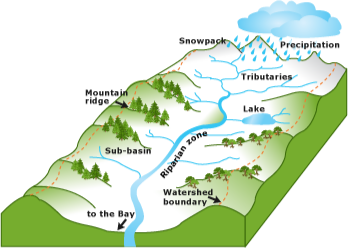Water is a very basic requirement of a human body to survive as well as do many other day-to-day activities. This has led to the development of settlements along the rivers or the other types of water bodies. You might have read this in my last post about Rights of Rivers. We all know about the glorious days of Sindhu Valley Civilization, Egyptian Civilization from the valley of the great River Nile, etc. Even in today’s world we see important cities associated with the rivers they rely on. Delhi is on the banks of Yamuna. Pune is on the confluence of rivers Mula and Mutha. Shanghai has River Yangtze while London has River Thames and Los Angeles has River Los Angeles with them. Today, let’s talk more about the rivers. How do they gather this huge amount of water? Let’s talk about watersheds.
What is a watershed?

Rivers draw their water from the area around them which is separated by a kind of ring of high elevation terrain like hills, mountains etc. This ring of hills or mountains forms a basin for the river which acts like a natural bowl. It keeps sending the water from its edge to the bottom of it. The line dividing this bowl from the adjacent one is called a ridgeline (Watershed boundary in the illustration). You can easily understand this with the image I have attached here.
With the vast spread of over 3.28 million square kilometers, India has several river basins. Sindhu basin, Ganga Basin, Brahmaputra Basin up in north to Kaveri Basin in South and Narmada and Tapi basins in west to Mahanadi in east and Godavari and Krishna in central India are some of the major river basins. In addition to these, there are hundreds of small river basins all across our 7500+ km coastline.

Micro-watersheds
When we consider local areas surrounding our cities, there are small hills and hillocks surrounding the city. These hills create micro-watersheds forming streams and nallas which subsequently merge in major rivers somewhere down the line. These micro-watersheds are very important for the city’s local climate and rainfall etc. They provide vital ecosystem services. The forest on hills acts as a carbon sink reducing the city’s carbon footprint.
Nowadays, Indian cities are witnessing uncontrolled sprawl of construction driven by the forces of greed. We have cut and quarried hills and hillocks for stone and earth leaving them deforested. Streams and Nallas are leveled with construction debris, etc. We have built buildings on hills and streams ultimately choking the natural drainage leading to the destruction of our micro-watersheds.
Because of these unchecked and uncontrolled actions, cities are witnessing flooding of roads, flash floods in rivers and streams since the last 10-15 years. If we do not straighten our act, our cities are going to face water scarcity, irregular rainfalls and more and more flash floods on our roads. It’s time for us to stand for our surroundings, our neighbourhood and houses. Every drop makes an ocean, if everyone in our cities starts taking care of our neighbourhood, and so, we’ll automatically take care of our cities.
Adi’s Journal
March 2021
This post is part of Blogchatter’s CauseAChatter


Leave a Reply